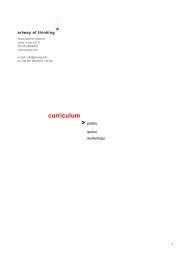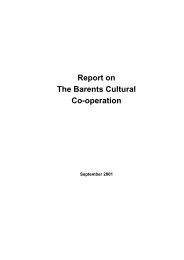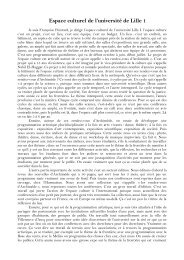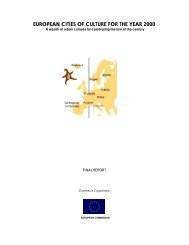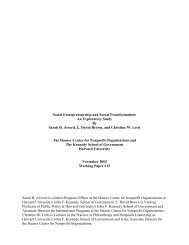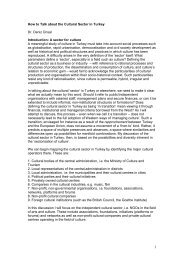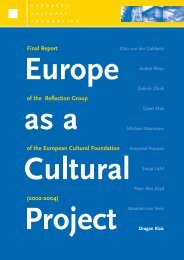A guide to the export and import of cultural goods between Russia ...
A guide to the export and import of cultural goods between Russia ...
A guide to the export and import of cultural goods between Russia ...
You also want an ePaper? Increase the reach of your titles
YUMPU automatically turns print PDFs into web optimized ePapers that Google loves.
Chapter 3: European Union Member States<br />
Irel<strong>and</strong><br />
national legislation are somewhat different from <strong>the</strong> EU categories. In some cases <strong>the</strong>y are more<br />
restrictive, e.g. paintings over 25 years old with a value threshold which originated in Irel<strong>and</strong>. In<br />
o<strong>the</strong>r cases, <strong>the</strong>y are less restrictive, e.g. decorative art objects over 70 years old with a value<br />
threshold which were made in Irel<strong>and</strong>. However, not all <strong>the</strong> 1997 Act has been enabled (i.e. <strong>the</strong><br />
law is not in force yet), in particular <strong>the</strong> sub sections describing <strong>goods</strong> which are restricted for<br />
<strong>export</strong>. Therefore, you must get advice from <strong>the</strong> Department <strong>of</strong> Arts, Sport <strong>and</strong> Tourism whe<strong>the</strong>r<br />
<strong>the</strong> <strong>cultural</strong> <strong>goods</strong> you want <strong>to</strong> <strong>export</strong> are currently covered by national legislation.<br />
What are my first steps? How do I plan this process <strong>and</strong> how long might it take?<br />
There are different application forms for <strong>export</strong> licences, depending on whe<strong>the</strong>r <strong>the</strong> <strong>cultural</strong><br />
<strong>goods</strong> fall under national legislation or EU legislation. You can get <strong>the</strong> forms from <strong>the</strong><br />
Department <strong>of</strong> Arts, Sports <strong>and</strong> Tourism (Cultural Institutions Division).<br />
There is no set time period for delivering a licence. You should ask <strong>the</strong> Division for advice<br />
on how long your application is likely <strong>to</strong> take.<br />
How do I find out if <strong>the</strong> art object I want <strong>to</strong> <strong>export</strong> is <strong>of</strong> national significance? Is <strong>the</strong>re a Public<br />
Inven<strong>to</strong>ry <strong>of</strong> <strong>cultural</strong> <strong>goods</strong> <strong>of</strong> special interest or <strong>import</strong>ance?<br />
There is a Register <strong>of</strong> Cultural Objects, as outlined under Section 48 <strong>of</strong> <strong>the</strong> 1997 Act. At<br />
present this covers paintings in <strong>the</strong> care <strong>of</strong> <strong>the</strong> National Gallery <strong>of</strong> Irel<strong>and</strong> <strong>and</strong> <strong>the</strong> Hugh<br />
Lane Municipal Gallery <strong>of</strong> Modern Art.<br />
Section 49 <strong>of</strong> <strong>the</strong> 1997 Act lists <strong>the</strong> types <strong>of</strong> <strong>cultural</strong> objects which may be subject <strong>to</strong> <strong>export</strong> restrictions.<br />
In general, <strong>the</strong> concern is <strong>to</strong> control <strong>the</strong> <strong>export</strong> <strong>of</strong> archaeological objects <strong>and</strong> those<br />
<strong>cultural</strong> <strong>goods</strong> (whe<strong>the</strong>r paintings, decorative art objects etc.) <strong>of</strong> a certain age <strong>and</strong> value which<br />
have been made in Irel<strong>and</strong> or which have been in <strong>the</strong> country for a designated length <strong>of</strong> time.<br />
Do museums <strong>and</strong> galleries need licences for temporary <strong>export</strong>s (e.g. a <strong>to</strong>uring exhibition)? Do<br />
non-pr<strong>of</strong>it organisations need <strong>export</strong> licences?<br />
Yes. Museums, galleries <strong>and</strong> non-pr<strong>of</strong>it organisations must apply for licences. Any <strong>cultural</strong><br />
<strong>goods</strong> that fall under any <strong>of</strong> <strong>the</strong> categories described in <strong>the</strong> Irish national legislation <strong>and</strong>/<br />
or EU <strong>export</strong> licence regulations must be covered by an <strong>export</strong> licence, whatever <strong>the</strong> type<br />
<strong>of</strong> applicant or purpose.<br />
Museums <strong>and</strong> galleries applying for a licence for temporary <strong>export</strong> should follow <strong>the</strong> same<br />
procedure outlined above. There is no statu<strong>to</strong>ry limit on <strong>the</strong> length <strong>of</strong> time an object can<br />
remain outside <strong>the</strong> country.<br />
I am a visual artist. Do I need a licence <strong>to</strong> <strong>export</strong> my own work?<br />
No. Art work which belongs <strong>to</strong> “<strong>the</strong> origina<strong>to</strong>r” (i.e. <strong>the</strong> artist who created it) does not require<br />
an <strong>export</strong> licence under <strong>the</strong> EU <strong>export</strong> licence legislation, whatever its age or value. The Irish<br />
national legislation (1997 Act) excludes from <strong>export</strong> restrictions a painting in <strong>the</strong> ownership<br />
123



